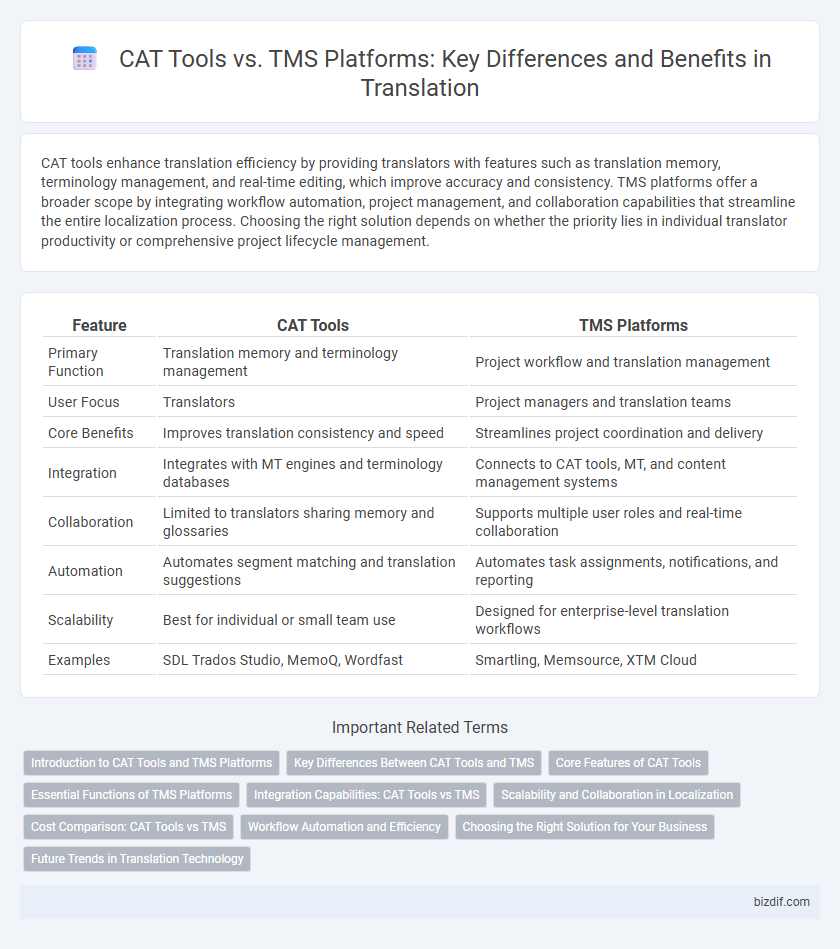CAT tools enhance translation efficiency by providing translators with features such as translation memory, terminology management, and real-time editing, which improve accuracy and consistency. TMS platforms offer a broader scope by integrating workflow automation, project management, and collaboration capabilities that streamline the entire localization process. Choosing the right solution depends on whether the priority lies in individual translator productivity or comprehensive project lifecycle management.
Table of Comparison
| Feature | CAT Tools | TMS Platforms |
|---|---|---|
| Primary Function | Translation memory and terminology management | Project workflow and translation management |
| User Focus | Translators | Project managers and translation teams |
| Core Benefits | Improves translation consistency and speed | Streamlines project coordination and delivery |
| Integration | Integrates with MT engines and terminology databases | Connects to CAT tools, MT, and content management systems |
| Collaboration | Limited to translators sharing memory and glossaries | Supports multiple user roles and real-time collaboration |
| Automation | Automates segment matching and translation suggestions | Automates task assignments, notifications, and reporting |
| Scalability | Best for individual or small team use | Designed for enterprise-level translation workflows |
| Examples | SDL Trados Studio, MemoQ, Wordfast | Smartling, Memsource, XTM Cloud |
Introduction to CAT Tools and TMS Platforms
CAT tools, or Computer-Assisted Translation tools, enhance translators' productivity through features like translation memory, terminology management, and automated quality checks. TMS platforms, or Translation Management Systems, provide comprehensive solutions for workflow automation, project tracking, and collaboration across multiple stakeholders. Both tools optimize different stages of the translation process, with CAT tools focusing on linguistic precision and TMS platforms emphasizing operational efficiency.
Key Differences Between CAT Tools and TMS
CAT tools primarily focus on aiding translators with features like translation memory, terminology management, and text segmentation, enhancing individual productivity. TMS platforms offer broader workflow management, enabling task assignment, collaboration, project tracking, and integration with multiple translation tools in a centralized system. The key difference lies in CAT tools being translator-centric software, while TMS platforms serve as comprehensive project management environments that streamline translation processes across teams.
Core Features of CAT Tools
CAT tools offer essential core features such as translation memory, glossary management, and real-time linguistic quality checks, which enhance translation consistency and efficiency. Unlike TMS platforms, CAT tools prioritize segment-level editing and context-aware suggestions for translators. These features streamline the translation process by reusing previously translated content and maintaining terminology accuracy across projects.
Essential Functions of TMS Platforms
TMS platforms integrate project management, workflow automation, and real-time collaboration to streamline translation processes across teams and languages. Essential functions include centralized resource management, vendor and client communication, and comprehensive reporting for ROI tracking. These capabilities enable scalable, efficient handling of complex localization projects beyond the scope of standalone CAT tools.
Integration Capabilities: CAT Tools vs TMS
CAT tools provide advanced linguistic resources such as translation memories and terminology databases, enhancing translation quality and consistency. TMS platforms integrate project management features, automating workflow and enabling seamless collaboration across teams. Efficient integration between CAT tools and TMS platforms streamlines the localization process by synchronizing translation assets and real-time project updates.
Scalability and Collaboration in Localization
CAT tools streamline translation workflows by leveraging translation memory and terminology management, enhancing consistency and efficiency for individual translators or small teams. TMS platforms provide robust scalability and collaboration features, enabling global localization teams to coordinate, manage workflows, and integrate with multiple CAT tools and third-party systems seamlessly. The choice between CAT tools and TMS platforms depends on project size and complexity, with TMS offering superior support for large-scale, collaborative localization efforts.
Cost Comparison: CAT Tools vs TMS
CAT tools generally involve lower upfront costs with subscription or one-time license fees ranging from $300 to $1,500 annually, suitable for freelance translators or small teams. TMS platforms, designed for larger-scale project management, often require higher investments, with pricing models based on the number of users or volume of processed content, potentially exceeding $10,000 per year. Cost efficiency depends on organizational needs, as CAT tools minimize expenses for individual use, while TMS platforms offer scalable solutions integrating translation workflow automation at a premium.
Workflow Automation and Efficiency
CAT tools streamline translation by leveraging translation memory and terminology management, significantly enhancing linguistic consistency and speed. TMS platforms integrate various processes, including project management, workflow automation, and reporting, optimizing overall operational efficiency. Combining CAT tools within a TMS environment results in seamless translation workflows, reducing manual tasks and accelerating project turnaround times.
Choosing the Right Solution for Your Business
CAT tools enhance translation accuracy and consistency by leveraging translation memories and terminology databases, making them ideal for linguists focused on high-quality output. TMS platforms streamline project management, workflow automation, and collaboration across teams, offering scalability for businesses handling large volumes of multilingual content. Selecting the right solution depends on your business needs: prioritize CAT tools for detailed translation work and TMS platforms for efficient project coordination and end-to-end localization management.
Future Trends in Translation Technology
CAT tools and TMS platforms are increasingly integrating AI-powered features such as neural machine translation and automated quality assurance to enhance efficiency and accuracy. Cloud-based solutions enable seamless collaboration among multilingual teams, while real-time project management dashboards improve workflow transparency. Future translation technology trends emphasize scalability, customization, and interoperability between CAT tools and TMS platforms to meet growing global content demands.
CAT Tools vs TMS Platforms Infographic

 bizdif.com
bizdif.com